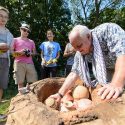Ancient kiln technology yields modern art
 UW-Eau Claire art student Katy Stepflug, above, loads a kiln on Picnic Point. Photo by Jeff Miller.  Burning wood in the kiln gives off not only heat – enough to hit 2,500 degrees – but also fly ash, which settles on the pieces, melts and creates a glassy surface in funky patterns. Photo by Jeff Miller.  Students and faculty camp out around the kiln to keep the fire stoked through the night. Photo by Jeff Miller. |
The proof is in the pottery. Proof, that is, of why a wood-fired kiln is worth all the smoke and ashes and interminable stoking. Student and faculty artists anxiously awaited that verdict last week as they unloaded their work from a new Japanese-style kiln constructed on Picnic Point.
How did this structure that looks like a twisted chimney pop up on Picnic Point? We’re coming to that story, which is chock full of altruism and institutional collaboration.
But first, let’s watch the kiln being carefully emptied. That’s when the artists see the magic wrought by burning wood: colors that cannot be described and textures and patterns that are gloriously irregular. So irregular that even accomplished ceramic artists can’t predict what will come out of a wood-fired kiln.
You could throw color names at the pieces plucked out of the Picnic Point kiln – charcoal, sienna, purple, buttery-yellow, jade-green – but they’d fall pathetically short of what the eye can capture. The literal beauty of it all is how burning some wood can vastly expand the possibilities of ceramics’ palette.
That’s what the Chinese discovered a millennia ago, and their technique spread into Korea and Japan. The Japanese call a wood-fired kiln anagama, and the Picnic Point kiln is an anagama design.
But there’s a huge difference between traditional Japanese anagamas and the one at UW–Madison: sheer size. That’s what makes it such a sweet teaching tool in ceramics, says Bruce Breckenridge, professor of ceramic art and education at UW–Madison.
“Most anagamas are so big they take weeks to fire up and weeks to cool down,” he says. So if the firing goes awry and the artist’s reaction at the end is “oops” (or a more colorful equivalent), months of work have gone up in smoke. In contrast, the smaller Picnic Point kiln, which is constructed of bricks and covered with clay, takes just two days to fire and two days to cool.
Breckenridge is part of a faculty threesome at two institutions that has shown what can happen when the spirit moves you to collaborate. Breckenridge knew he had a fellow kiln-lover in Mark Kenoyer, professor of anthropology at UW–Madison and expert on the ancient Indus civilization and its bead-making art.
Kenoyer offers a summer course on Ancient Technology and Invention that he teaches on Picnic Point, where his students use a small wood-fired kiln built for that purpose. It sits just a few yards from the new and larger anagama kiln.
Breckenridge and Kenoyer were joined in their kiln-quest by Mike Weber, a professor of art at UW-Eau Claire who studied under Breckenridge and earned two degrees at UW–Madison.
Weber also studied under a Japanese master, Shiro Tsujimora. While studying to be a Buddhist monk, Tsujimora discovered that ceramics was his calling, so it was off with the robes and into the studio.
He became a renegade artist – and a millionaire – by building small versions of the traditional anagama behemoth, a technique he taught to Weber. In turn, Weber built three anagamas in Bayfield County for use in summer workshops.
Now here’s where the collaboration comes in: When asked by Breckenridge, Weber agreed to design the anagama on Picnic Point at no charge. Then he and his students joined Breckenridge’s students in building the kiln this spring, and they even came down a second time to help fire it up.
Why did Weber do it? “Bruce and I are teachers,” he says, “and it’s hard for students to learn anything from one firing a year in a big kiln.” But it won’t be his students who’ll use it, right? “It’s total altruism,” says Breckenridge.
If you had been there when Weber, Breckenridge and students from the two schools were shoving wood into the kiln round-the-clock, you would have seen smiles on their sweaty faces. And you would have seen more smiles as students removed their still-warm pieces from the kiln four days later.
They were smiling at how the alchemy of wood and fire can change the surface of clay from plain to jaw-dropping beautiful. The key, says Weber, is “the nice dirty flame.”
He means that burning wood in the kiln gives off not only heat – enough to hit 2,400-2,500 degrees – but also fly ash, which settles on the pieces, melts and creates a glassy surface in funky patterns. “The firing process becomes part of the esthetic,” says Breckenridge.
The process is unpredictable because the ash settles in different amounts on different parts of each piece, depending on where it’s stacked in the kiln. Not only that, says Weber, “Different woods produce different ash because one species may pull up different minerals from the earth than another.”
A common alternative to all this trouble is an electric kiln or “switch-flicker,” as some call it, which provides clean, predictable heat. But there’s something about an anagama that’s “very romantic,” as Weber puts it.
And part of that romance is the art that comes out of its maw, bearing colors from another, more molten world.
Tags: archaeology, arts, Lakeshore Nature Preserve, learning

